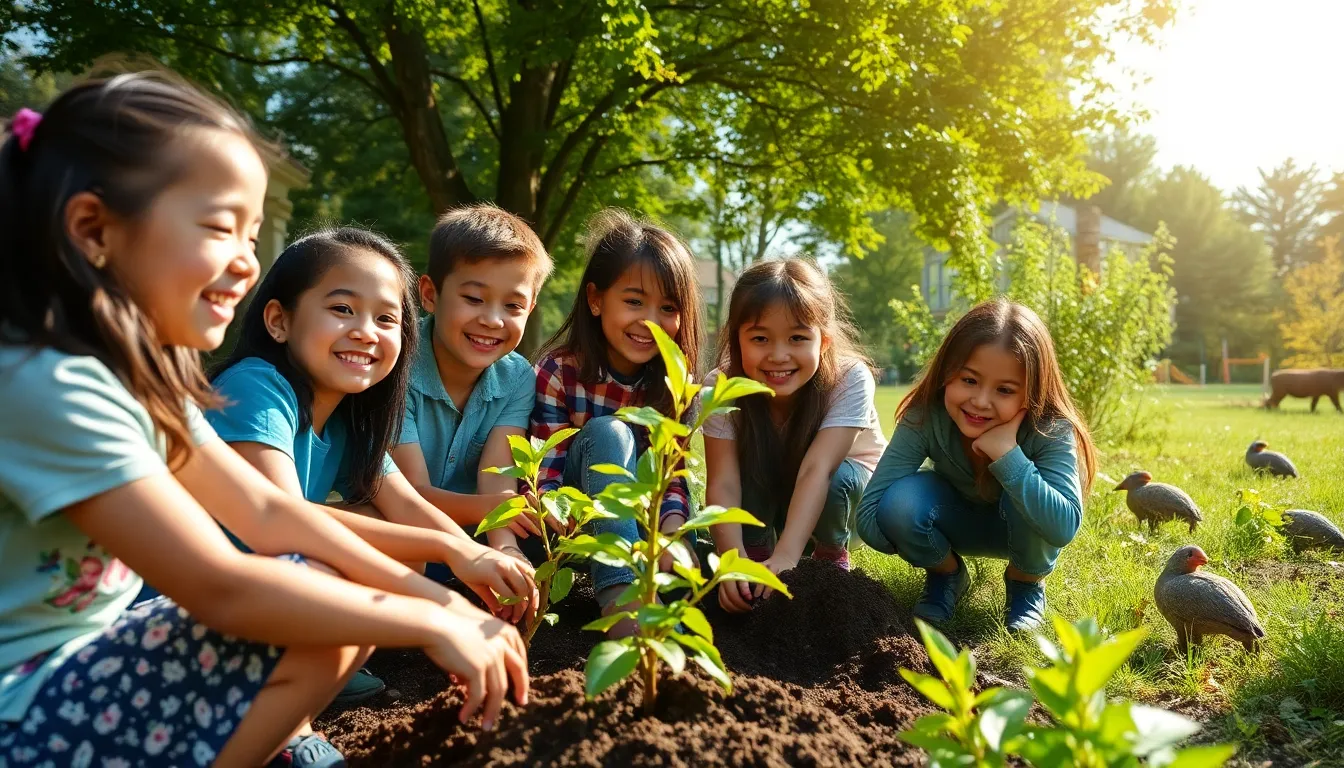Table of Contents
ToggleIn a world where kids are glued to screens and nature often takes a backseat, conservation child development emerges as a superhero. It’s not just about saving the planet; it’s about nurturing the next generation of eco-warriors who can appreciate a tree without needing a Wi-Fi connection. Imagine children who not only know where their food comes from but also understand the importance of preserving the environment.
This approach combines the wonders of childhood with the urgent need for environmental stewardship. By engaging kids in hands-on conservation activities, they develop a sense of responsibility and connection to the earth. Plus, who wouldn’t want to see kids trading their video games for planting trees and exploring the great outdoors? Conservation child development isn’t just a trend; it’s a movement that promises a brighter future for both children and the planet.
Understanding Conservation Child Development
Conservation child development encompasses the integration of environmental education into children’s growth processes. This concept emphasizes the importance of fostering a bond between children and nature.
Definition of Conservation
Conservation refers to the practice of protecting and managing natural resources sustainably. This includes efforts to preserve ecosystems, wildlife, and biodiversity. It also involves educating individuals about the significance of protecting the environment. Effective conservation initiatives encourage responsible use of resources, ensuring that future generations can enjoy them. Authentication of environmental challenges, such as climate change, fosters a foundational understanding among children. Through conservation efforts, children learn not only about their responsibilities toward nature but also about the delicate balance that sustains life on Earth.
Importance in Child Development
Recognizing the importance of conservation in child development shapes the next generation’s mindset. Engaging children in conservation activities cultivates a sense of stewardship toward the environment. Such involvement encourages empathy for living things, fostering connections with nature. Studies indicate that children who actively participate in conservation projects develop stronger problem-solving skills. Personal growth occurs as they confront real-world issues. Enhanced self-esteem arises when children contribute positively to their communities. Sitting in nature and observing ecosystems reinforces learning and supports cognitive development. Building this knowledge base leads to environmentally responsible adults who advocate for sustainability.
Principles of Conservation Child Development


Conservation child development incorporates principles that foster cognitive, emotional, and social growth through environmental engagement. This holistic approach nurtures a generation of mindful stewards of the planet.
The Role of Conservation in Cognitive Growth
Conservation practices enhance cognitive development in children. Engaging with nature stimulates critical thinking and problem-solving skills. Hands-on experiences, such as planting trees or observing wildlife, encourage inquiry and exploration. Children gain knowledge about ecosystems and biodiversity, fostering curiosity about the world around them. Increased awareness of environmental issues can also lead to better decision-making. Development occurs through real-world applications of scientific concepts, showing how theory connects to practical situations. Ultimately, these experiences build a foundation for lifelong learning and responsible citizenship.
Emotional and Social Development
Emotional and social skills also flourish through conservation activities. Collaborating with peers during environmental projects enhances teamwork and communication abilities. Children develop empathy for living beings, as they learn the importance of preserving biodiversity. Participating in conservation efforts cultivates a sense of belonging and responsibility toward the community and environment. Developing connections with nature can reduce stress and anxiety, promoting overall emotional well-being. Recognizing their potential to effect change fosters self-confidence and resilience. These experiences create environmentally aware individuals who are equipped to advocate for sustainable practices.
Strategies for Promoting Conservation
Promoting conservation in child development involves integrating effective educational approaches and fostering community involvement. Both aspects help children connect with the environment and understand their role in preserving it.
Educational Approaches
Hands-on learning experiences significantly enhance environmental knowledge in children. Engaging in outdoor classrooms allows children to explore ecosystems firsthand. Incorporating field trips to natural reserves provides opportunities for observation and inquiry. Environmental education should be part of the curriculum, emphasizing concepts like biodiversity and sustainability. Workshops with interactive activities encourage critical thinking, developing problem-solving abilities. Utilizing books and multimedia resources about conservation aids in reinforcing these concepts. Utilizing art, science projects, and storytelling can deepen children’s understanding of their environment. Overall, diverse educational methods promote a profound appreciation for nature.
Community Involvement
Community participation strengthens children’s connection to conservation efforts. Organizing local clean-up days allows kids to contribute actively while developing teamwork skills. Involving families in conservation initiatives fosters a collective spirit of stewardship. Planting community gardens offers hands-on learning about ecosystems, encouraging responsibility. Partnerships with local environmental organizations can provide resources and support for educational programs. Organizing workshops on sustainability can empower children and families alike to adopt eco-friendly practices. By creating community events that focus on conservation, children gain valuable insights into their role in environmental protection. Meaningful involvement leads to a shared commitment to protecting natural resources.
Challenges in Conservation Child Development
Conservation child development faces several challenges that hinder its effectiveness and reach. Understanding these obstacles is crucial for creating impactful solutions.
Socioeconomic Factors
Socioeconomic status significantly influences children’s access to conservation programs. Families with limited financial resources often struggle to engage in outdoor activities and education. Urban environments may lack natural spaces, restricting opportunities for hands-on experiences. Moreover, schools in low-income areas frequently lack funding for environmental education. This inadequate support limits children’s awareness of conservation efforts. Various community programs strive to bridge these gaps, but disparities persist, highlighting the need for equitable access to conservation activities.
Cultural Differences
Cultural attitudes towards nature can vary widely, impacting children’s conservation engagement. Some cultures prioritize agricultural practices over environmental preservation, which may lead to a disconnect with ecological education. In many communities, traditional values shape interactions with the environment. These differing perspectives can make it challenging to introduce contemporary conservation principles. Effective strategies must respect and integrate local cultural beliefs while promoting sustainable practices. Engaging cultural leaders can facilitate acceptance of conservation initiatives, fostering a collaborative approach to environmental stewardship.







